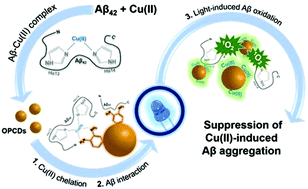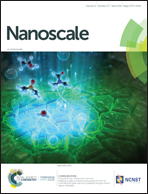Multifunctional carbon dots as a therapeutic nanoagent for modulating Cu(ii)-mediated β-amyloid aggregation†
Abstract
The abnormal self-assembly of cerebral β-amyloid (Aβ) peptides into toxic aggregates is a hallmark of Alzheimer's disease (AD). Here, we report on multifunctional carbon dots that can chelate Cu(II) ions, suppress Aβ aggregation, and photooxygenate Aβ peptides. Copper ions have high relevance to AD pathogenesis, causing Cu(II)-mediated Aβ aggregation and oxidative damage to neuronal cells. For effective conjugation with Cu(II)-bound Aβ complexes, we have designed carbon dots that possess nitrogen (N)-containing polyaromatic functionalities on their surface by employing o-phenylenediamine (OPD) as a polymerization precursor. We demonstrate that the polymerized OPD (pOPD)-derived carbon dots exhibit multiple capabilities against Cu(II)-mediated Aβ aggregation. Furthermore, the pOPD-derived carbon dots exhibited dramatically enhanced absorption and fluorescence upon coordination with Cu(II) ions and effectively photooxygenated Aβ peptides. The photodynamically modulated Aβ residues lost the propensity to coordinate with Cu(II) and to assemble into toxic aggregates. This work demonstrates the potential of carbon dots as a multifunctional β-sheet breaker and provides a promising anti-amyloidogenic strategy for future Aβ-targeted AD treatments.



 Please wait while we load your content...
Please wait while we load your content...